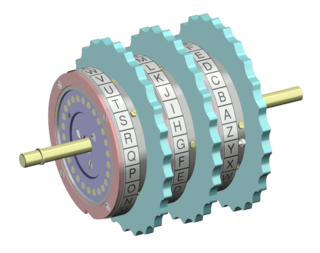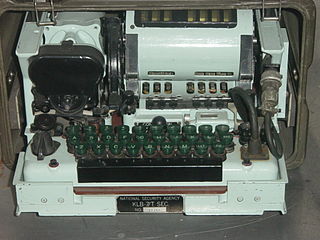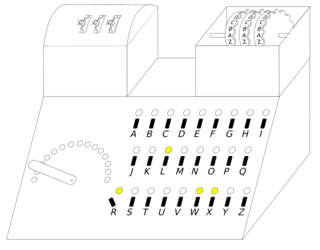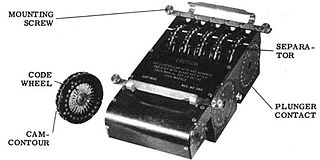
In cryptography, a cipher is an algorithm for performing encryption or decryption—a series of well-defined steps that can be followed as a procedure. An alternative, less common term is encipherment. To encipher or encode is to convert information into cipher or code. In common parlance, "cipher" is synonymous with "code", as they are both a set of steps that encrypt a message; however, the concepts are distinct in cryptography, especially classical cryptography.

The Enigma machine is a cipher device developed and used in the early- to mid-20th century to protect commercial, diplomatic, and military communication. It was employed extensively by Nazi Germany during World War II, in all branches of the German military. The Enigma machine was considered so secure that it was used to encipher the most top-secret messages.

In the history of cryptography, Typex machines were British cipher machines used from 1937. It was an adaptation of the commercial German Enigma with a number of enhancements that greatly increased its security. The cipher machine was used until the mid-1950s when other more modern military encryption systems came into use.
In cryptography, a substitution cipher is a method of encrypting in which units of plaintext are replaced with the ciphertext, in a defined manner, with the help of a key; the "units" may be single letters, pairs of letters, triplets of letters, mixtures of the above, and so forth. The receiver deciphers the text by performing the inverse substitution process to extract the original message.

In the history of cryptography, the "System 97 Typewriter for European Characters" (九七式欧文印字機) or "Type B Cipher Machine", codenamed Purple by the United States, was an encryption machine used by the Japanese Foreign Office from February 1939 to the end of World War II. The machine was an electromechanical device that used stepping-switches to encrypt the most sensitive diplomatic traffic. All messages were written in the 26-letter English alphabet, which was commonly used for telegraphy. Any Japanese text had to be transliterated or coded. The 26-letters were separated using a plug board into two groups, of six and twenty letters respectively. The letters in the sixes group were scrambled using a 6 × 25 substitution table, while letters in the twenties group were more thoroughly scrambled using three successive 20 × 25 substitution tables.

In the history of cryptography, the ECM Mark II was a cipher machine used by the United States for message encryption from World War II until the 1950s. The machine was also known as the SIGABA or Converter M-134 by the Army, or CSP-888/889 by the Navy, and a modified Navy version was termed the CSP-2900.

In cryptography, a rotor machine is an electro-mechanical stream cipher device used for encrypting and decrypting messages. Rotor machines were the cryptographic state-of-the-art for a prominent period of history; they were in widespread use in the 1920s–1970s. The most famous example is the German Enigma machine, the output of which was deciphered by the Allies during World War II, producing intelligence code-named Ultra.

The Lorenz SZ40, SZ42a and SZ42b were German rotor stream cipher machines used by the German Army during World War II. They were developed by C. Lorenz AG in Berlin. The model name SZ was derived from Schlüssel-Zusatz, meaning cipher attachment. The instruments implemented a Vernam stream cipher.

The Siemens & Halske T52, also known as the Geheimschreiber, or Schlüsselfernschreibmaschine (SFM), was a World War II German cipher machine and teleprinter produced by the electrical engineering firm Siemens & Halske. The instrument and its traffic were codenamed Sturgeon by British cryptanalysts.

The bombe was an electro-mechanical device used by British cryptologists to help decipher German Enigma-machine-encrypted secret messages during World War II. The US Navy and US Army later produced their own machines to the same functional specification, albeit engineered differently both from each other and from Polish and British bombes.
In cryptography, a weak key is a key, which, used with a specific cipher, makes the cipher behave in some undesirable way. Weak keys usually represent a very small fraction of the overall keyspace, which usually means that, if one generates a random key to encrypt a message, weak keys are very unlikely to give rise to a security problem. Nevertheless, it is considered desirable for a cipher to have no weak keys. A cipher with no weak keys is said to have a flat, or linear, key space.
Cryptanalysis of the Enigma ciphering system enabled the western Allies in World War II to read substantial amounts of Morse-coded radio communications of the Axis powers that had been enciphered using Enigma machines. This yielded military intelligence which, along with that from other decrypted Axis radio and teleprinter transmissions, was given the codename Ultra.

The TSEC/KL-7, also known as Adonis was an off-line non-reciprocal rotor encryption machine. The KL-7 had rotors to encrypt the text, most of which moved in a complex pattern, controlled by notched rings. The non-moving rotor was fourth from the left of the stack. The KL-7 also encrypted the message indicator.
In the history of cryptography, the NEMA , also designated the T-D (Tasten-Druecker-Maschine), was a 10-wheel rotor machine designed by the Swiss Army during the World War II as a replacement for their Enigma machines.

In cryptography, Fialka (M-125) is the name of a Cold War-era Soviet cipher machine. A rotor machine, the device uses 10 rotors, each with 30 contacts along with mechanical pins to control stepping. It also makes use of a punched card mechanism. Fialka means "violet" in Russian. Information regarding the machine was quite scarce until c. 2005 because the device had been kept secret.

The cyclometer was a cryptologic device designed, "probably in 1934 or 1935," by Marian Rejewski of the Polish Cipher Bureau's German section (BS-4) to facilitate decryption of German Enigma ciphertext. The original machines are believed to have been destroyed shortly before the German invasion of Poland that launched the Second World War, to prevent the Germans learning that their cipher had been broken.
In cryptography, the clock was a method devised by Polish mathematician-cryptologist Jerzy Różycki, at the Polish General Staff's Cipher Bureau, to facilitate decrypting German Enigma ciphers. The method determined the rightmost rotor in the German Enigma by exploiting the different turnover positions. For the Poles, learning the rightmost rotor reduced the rotor-order search space by a factor of 3. The British improved the method, and it allowed them to use their limited number of bombes more effectively.

The Combined Cipher Machine (CCM) was a common cipher machine system for securing Allied communications during World War II and, for a few years after, by NATO. The British Typex machine and the US ECM Mark II were both modified so that they were interoperable.

SIGCUM, also known as Converter M-228, was a rotor cipher machine used to encrypt teleprinter traffic by the United States Army. Hastily designed by William Friedman and Frank Rowlett, the system was put into service in January 1943 before any rigorous analysis of its security had taken place. SIGCUM was subsequently discovered to be insecure by Rowlett, and was immediately withdrawn from service. The machine was redesigned to improve its security, reintroduced into service by April 1943, and remained in use until the 1960s.
The Schlüsselgerät 39 (SG-39) was an electrically operated rotor cipher machine, invented by the German Fritz Menzer during World War II. The device was the evolution of the Enigma rotors coupled with three Hagelin pin wheels to provide variable stepping of the rotors. All three wheels stepped once with each encipherment. Rotors stepped according to normal Enigma rules, except that an active pin at the reading station for a pin wheel prevented the coupled rotor from stepping. The cycle for a normal Enigma was 17,576 characters. When the Schlüsselgerät 39 was correctly configured, its cycle length was characters, which was more than 15,000 times longer than a standard Enigma. The Schlüsselgerät 39 was fully automatic, in that when a key was pressed, the plain and cipher letters were printed on separate paper tapes, divided into five-digit groups. The Schlüsselgerät 39 was abandoned by German forces in favour of the Schlüsselgerät 41.













